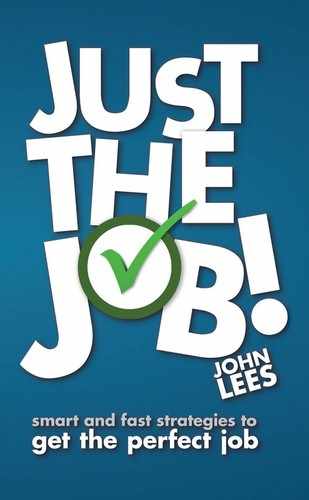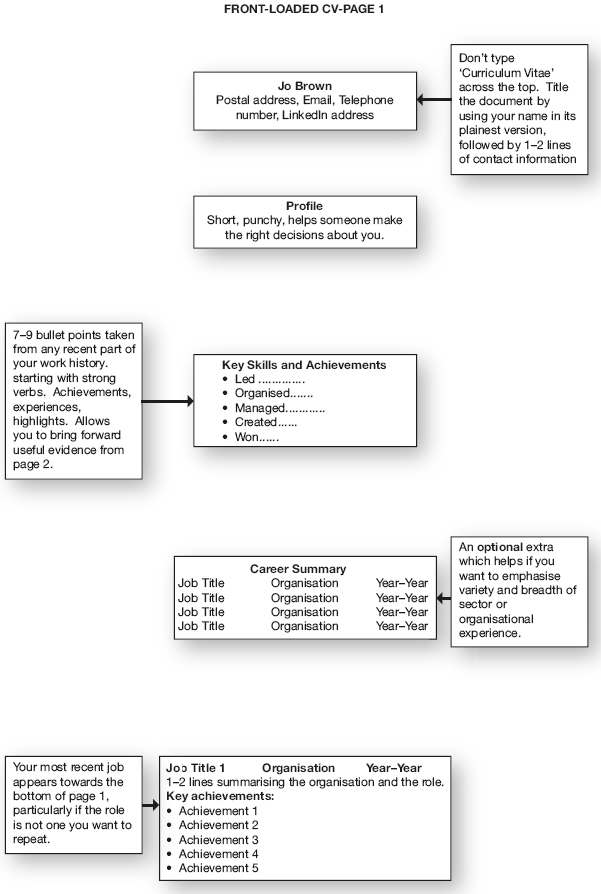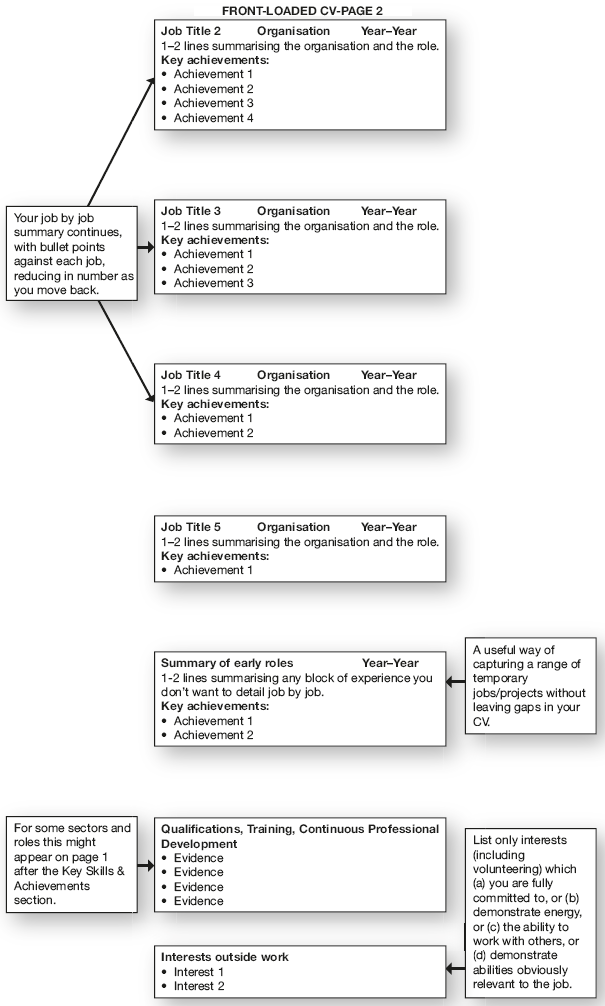Write your draft CV
THIS CHAPTER LOOKS AT:
- Choosing an effective CV structure
- Creating an Experience Databank
- Filtering, editing and composing a CV that gets you into the interview room
- How to design a CV if you hope to change sector
WHEN DO I NEED TO GET MY CV READY?
The vast majority of job seekers write a CV very early in the process and then tinker with it until they get a job. It never quite gets the message across, and even after a job offer candidates are unsure which parts worked. ‘Candidates rush into getting their CVs written too quickly,’ writes Keith Busfield, Director of Anderson Yorke. ‘It’s their first big demand of an outplacement programme. What people really need is an objective and a strategy. Writing your CV too soon is missing the plot.’
Your CV will remain in draft while it undergoes some market testing, but you may need a working document ready at short notice. Level 1 conversations (Chapter 7) will help you fill out and shape your CV. Level 2 conversations (Chapter 9) will provide a market test so your CV is fit for purpose when you start applying for advertised jobs.
CV ESSENTIALS
Too many candidates rely too heavily on their CV to unlock every stage of the process. A good CV will persuade people to see you, but it won’t get you the job. No matter how brilliant a document you prepare, even a top notch CV will have far less effect than an average programme of outward-facing conversations. There are many CV guides out there, often with conflicting opinions and guidance. Here is an overview which is designed to take away the biggest headaches of CV writing.
- Start as you mean to go on. Keep your CV businesslike – don’t head the document ‘Curriculum Vitae’ which sounds old fashioned. Just put your name at the top in its simplest form – no middle names, no letters after your name.
- Think of initial impact. An initial decision is made about you in the first 50 words, a firm decision in the first half page. Give more attention to the first half page than any other part of the document.
- Say the things that matter fast. Early on, while you’ve got the reader’s attention, communicate the headlines – your background, skills and tangible achievements.
- It’s not a biography, it’s an advertisement. Don’t overwhelm the reader with evidence, particularly if it’s a series of chopped up job descriptions. A CV is there to communicate a handful of ideas, not your life’s work. Give the reader a short list of reasons to invite you in.
- Work to the shopping list. Match your CV to the top five or six wants on the employer hit list.
- Use a flexible but effective formula. Write a profile and a series of high impact achievement bullet points (see ‘The Hybrid CV’ below).
- Think impact. Make it look good, with plenty of white space and bullet points of varying length to ensure it’s easy to read.
- Avoid the ‘so what?’ factor. Don’t list duties which are obvious and entirely predictable from your job title, and don’t list skills which make you sound like somebody much more junior.
- Lead with the right language. Avoid long paragraphs which will never be read. Use bullet points which begin with action verbs (e.g. ‘led’, ‘initiated’, ‘managed’).
- Emphasise qualifications only if it makes a difference to getting shortlisted. Otherwise list them deeper in the document and give far more emphasis to skills and experience.
- Don’t fall into predictable traps – e.g. sounding out of touch with the modern workplace if you are an older candidate, or sounding naively proud of modest experience if you are straight out of full-time education.
- Don’t fuss. Avoid acronyms, jargon, complicated explanations or details. Keep sentences short, avoiding sub-clauses.
- Don’t apologise. A CV is no place to start justifying past decisions or actions.
- Don’t eulogise. Describe, explain, but don’t over-sell. Dudley Harrop writes:
Keep your CV profile brief and factual. ‘Highly motivated and successful engineer; works well on own or in a team’ is not a fact. It’s your opinion of yourself, unlikely to be unbiased. Whereas ‘Qualified chartered accountant with 15 years’ experience in packaging sector’ – is a fact and is information the reader wants to know.
- Avoid features which worry the reader. Don’t leave obvious gaps. If you dropped out of a course or job, provide a short and simple reason. Double check company and product names, dates, figures.
- Don’t go overboard on information on jobs you did a long time ago. Dudley Harrop comments:
Don’t include short jobs that add nothing to the overall impact of the CV. You might bundle a few of them together and label those years something like: ‘Worked with a number of medium-sized companies to extend experience of retail.’
CV FORMATS DEMYSTIFIED
An Internet trawl will present you with a bewildering array of CV examples. How do you choose? First, find CVs that match the market and sector you’re aiming to get into, and don’t get distracted by CV examples which (a) only work in other cultures or countries or (b) are so novelty-driven, design-heavy or gimmicky that they just won’t fly unless you’re applying for a highly creative role (in which case ignore all rules and be original). For 90% of job seekers a conventional format will work. See your choices on page 61.
So, how to choose? If agencies always offer you the same kind of job you did in the past, you’ve already discovered one major limitation of the Chronological CV. If you’ve tried the Functional CV you may not have received any feedback at all, because they are often ignored. A Profile-led CV might work well, depending on how well the profile is written, but can also irritate some employers.
There is, in my experience, only one format which works well in situations where you require a handover message – what you would say if you were in the room, handing the document across. You might say something like: ‘before you read this, let me tell you a couple of things …’. The problem is that you probably won’t be in the room, so you have to design a document that works without your verbal handover. This is why, if you want to make a career change, you’ll probably need to begin with a profile.

FORMAT AND IMPACT
There are many urban myths about how quickly a CV gets read. Experienced recruiters object to the idea that a CV is read in 30 seconds, and the best ones look at every detail. However what is uncertainly true is this: a selector will have made critical decisions about you about half way down page one.
Here’s a simple test for your CV. Imagine you had it with you at a social gathering. A stranger asks you to tear off and give him just the first third of the first sheet. Would that stranger have enough information to spend the rest of the evening telling people what you have to offer? That’s the part of your CV that gets read in detail. Keep your CV to an absolute maximum of three pages (two is better), but focus all your attention on the first half of page 1. This piece of information trumps all other CV advice, and helps you decide on which CV format to use.
Which format should you use? Cheat. Take the best of all formats and combine them in a structure which shapes a decision maker’s thinking in the first 30 seconds. The opening section therefore needs to provide a clear picture of where you fit into the world of work, what you do well, your key skills and experience, and your track record. There may be other refinements, but in general that’s about it. The Front-Loaded CV ensures that your CV hands itself over when you are not in the room, and gets the reader to make the decision ‘this is someone we ought to see’ in the opening seconds.
(See also the example CV material downloadable free from www.johnleescareers.com)
FILTERING IN – BUILDING YOUR EXPERIENCE DATABANK
Before writing a CV, spend time collating evidence without applying any kind of filter. Grab a notebook and start writing out your Experience Databank – a list of the raw ingredients of your work history. Don’t do this in the way you normally write your CV, job by job – write them down in the random order that you remember them. Keep writing down examples of positive experiences where you have used skills usefully and made something happen. Start by remembering those times when things went well at work – when you completed something difficult, when you received positive affirmation, when a plan came together, ….
Write down an entirely unedited list of highlights taken from any part of your experience, including life outside work. Don’t choose what’s good and what isn’t, just keep writing, perhaps in the course of a long train journey. Think of it like reviewing videos of your past experience in seductive slow motion – keep looking for times when you did something worth pressing ‘pause’ for.
Leave the list overnight and add to it the next day. Ask friends and family to help jog your memory. Think about paid work, unpaid work, voluntary commitments, hobbies and interests. It might help to review previous job descriptions, diaries and work records, thinking of each job as a series of projects. Don’t forget learning experiences. Use bullet points or short phrases which remind you of details which you will flesh out later.
Keep on adding examples. Your list will naturally be far too long and detailed for your CV, and that’s just fine. This is your unedited, unfiltered database of the excellent, the impressive, the random and the ordinary. Don’t start to edit it or extract from it until you feel it is complete, even if it runs to many pages. Keep racking your brain, making sure you include anything that could be useful – take special care not to exclude anything at this stage.
When you can’t think of anything to add, record the list electronically. Don’t edit, re-order or filter as you type. Your aim is to produce an unedited master list containing all your raw material. Save this file as Experience Databank Master. Keep this master list intact; you will need it in the future as your career develops.
FILTERING OUT
When, and only when, you can’t think of anything else to add to your master document, you can start to organise information. Save your document as a new file: Experience Databank Edit. Now you can play with the contents. You might reshuffle the information so it is in date order. You might highlight different themes, or put information into different categories, for example all your achievement evidence which relates to people skills.
You might want to save a copy of this working file as Databank for New CV. Now is the time to relate your databank to the skills and attributes required by jobs you will be chasing. If it’s just one job in your sights, that’s straightforward – match carefully. If you are looking at a range of roles, think about the cluster of information which is likely to impress most – knowledge, strengths, experience and achievements. At this point you may need to get help from a career coach or someone who has experience of short-listing evidence you should exclude or include.
When reviewing material, ask ‘so what?’ – what looks routine and ordinary? What evidence makes you look like someone three rungs below you in the organisation? What listed skills are taken for granted in someone at your level and therefore carry no weight (e.g. a senior sales manager listing skills in Word and PowerPoint)? Some phrases make you sound like someone straight out of full-time education. The table below sets out the top CV clichés most likely to get you binned.
Next, highlight your strongest points – potential page 1 material. Ask yourself if there is any evidence you haven’t yet recorded. Remember to copy fresh material back into your Experience Databank Master. The evidence you draw out will help your interview strategy as well as your CV, and being able to summarise your strengths will add sparkle to networking conversations. However, for now, just composing a master list will lift your confidence and start to get you focused.
CAREER CHANGE
Career coach Stuart McIntosh advises:
Where there is a link between your previous career and the job you are targeting then the CV should be reverse chronological demonstrating your skills and experience in the context of the target market.
Where you are looking for a sector change you will be up against candidates whose experience is more relevant, so think carefully about the impact of your CV. McIntosh adds:
Consider what a CV reader will think after a six-second scan or sift checking – is there a strong enough link between your job title/ex-employer name and the job being advertised?
If the link is weak, you may have difficulties, particularly if you don’t manage the opening part of your CV with great care. Use the right structure and your CV can help you get shortlisted if you don’t have sector experience. How? Firstly, get a strong feel for the job. Take any offered opportunity to telephone to ask questions about the role (see Chapter 11). Ask around to be sure what evidence to use, and what language to pitch in. When you adapt your CV to the task of sector change, your job is to actively help readers make connections between your experience and the reality of the job.
Having begun with a thorough trawl of your experience you should now have a draft CV to take you forward into your first discussions. Later, you will sharpen up the primary messages in your CV ready for higher level conversations (see Chapter 8).
Writing a CV to help you change career
- Expand and explain past job titles to create the idea that you have done virtually the same job in another sector.
- Mention on page 1 any background experience or learning that may help. Mention the names of organisations that will be recognised by a decision maker.
- Provide a list of transferable skills on page 1, using terms that your new target sector will not only understand but find attractive.
- Spell out ways that your study and training history have equipped you with relevant skills and underpinning knowledge for your target sector.
- Lessen the impact of your actual career history by only including your most recent job on page 1 and putting the rest of your career history on page 2.
- Finally, and most importantly, make sure that your CV profile sells the idea of career change. Don’t start by identifying yourself through a profession or role label that you don’t want to repeat. Do emphasise skills, qualities and know-how which help sell you into the role, and also spell out reasons why your background might be an asset.


